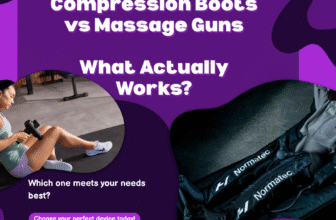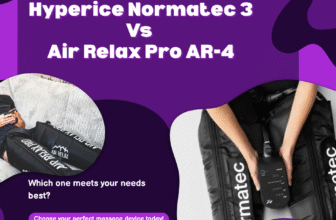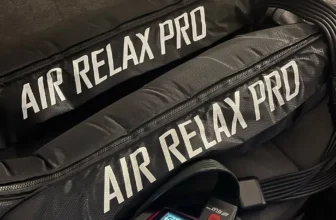13 Must-Have Sports Protective Gear Athletes Swear By in 2025
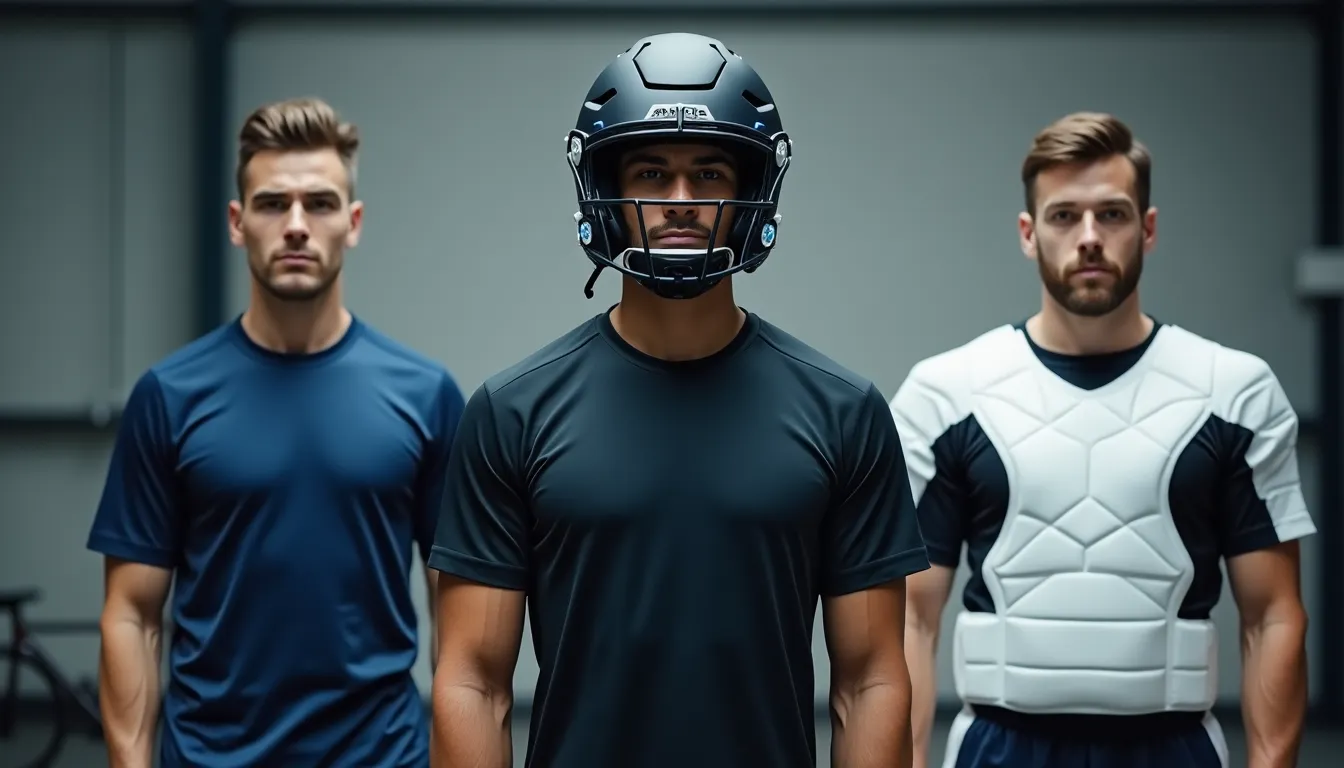
Over 3.5 million children under 14 in the USA need medical treatment for sports injuries each year. Sports-related activities cause 21% of traumatic brain injuries among American children. These statistics paint a concerning picture, highlighting the critical need for effective sports injury prevention strategies.
The right sports protective gear can dramatically reduce these risks. Athletes who use proper athletic safety equipment can prevent more than half of all sports injuries. Helmets reduce head injuries by up to 85%, and protective eyewear stops 90% of eye injuries. The right safety gear truly makes all the difference in ensuring athlete well-being.
We created this complete guide to the 13 most effective pieces of sports safety gear for 2025. You’ll find everything you need to stay safe while performing at your best, whether you’re a professional athlete or weekend warrior. From innovative protective equipment to cutting-edge protective technology, we cover it all.
Smart Helmets with Impact Sensors

Smart helmets mark a big step forward in sports protective gear technology. These state-of-the-art devices, featuring advanced helmet technology, have embedded sensors that detect and measure impact forces. They provide vital data about potential head injuries, making them crucial for concussion prevention.
Smart helmet features for 2025
Modern smart helmets employ several sensor types to monitor head impacts:
- Accelerometers and gyroscopes measure both linear and rotational forces during head collisions
- Immediate data transmission sends impact information to the sidelines
- Automated alerting systems activate when impacts go beyond preset thresholds
- Fall detection with SOS alerts notifies emergency contacts with GPS location
- Bluetooth connectivity works up to 325 feet
Some models also come with voice command features, built-in HD cameras, and augmented reality displays. These boost communication between coaches and players, enhancing the overall performance and safety wear experience.
Smart helmet pricing and availability
Quality smart helmet technology prices vary based on features:
Riddell’s Axiom football helmet with standard InSite technology costs about $750 per helmet for team purchases. The price includes impact sensing hardware, but an extra subscription is needed for analytics services.
Motorcycle riders can choose options like the LIVALL MC1 Pro. It has similar impact detection technology plus brake warning lights and 8-10 hour battery life.
Premium models like VICIS ZERO1 cost around $1,500 per helmet. These helmets are a great investment for serious athletes and teams that want maximum safety and high-tech sports protection.
Smart helmet benefits for sports safety
Smart helmets excel at detecting dangerous impacts right away. They alert coaches or medical staff when a major impact happens. This allows them to check on players immediately, significantly improving sports injury prevention efforts.
Analytics subscriptions give coaches detailed reports about impact patterns. They can then adjust training methods to reduce Head Impact Exposure (HIE). This evidence-based approach shows promise. Some schools report fewer concussions after they started using smart helmet technology.
These advanced protective systems help prevent long-term brain injuries. They identify concerning impacts before they build up into more serious conditions, making them an essential component of modern athletic safety equipment.
Custom-Fit Mouthguards with AI Scanning
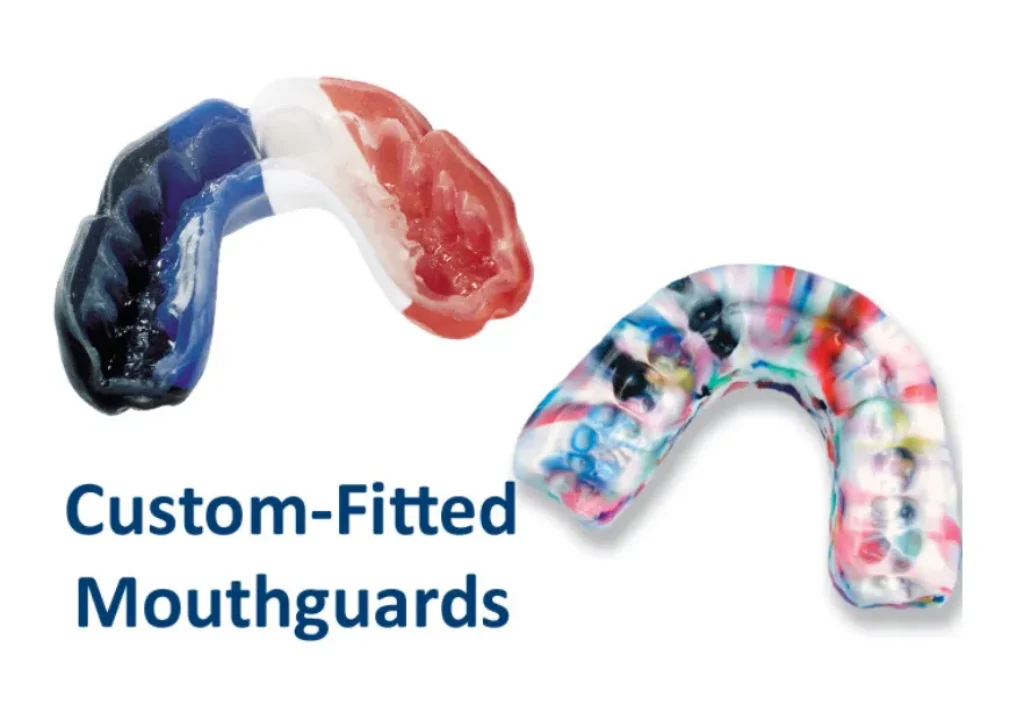
A mouthguard’s perfect fit plays a crucial role in comfort and safety. Modern sports protective gear now includes AI-scanned mouthguards that provide unique protection through cutting-edge protective technology.
How AI scanning improves mouthguard fit
Store-bought mouthguards often lack precision. AI and 3D scanning have reshaped this vital safety equipment for sports. The process starts with scanning an athlete’s jaw to create a digital model. This data then guides custom mouthguard production with remarkable accuracy. These precisely measured guards fit tightly on teeth and provide better protection than store-bought options.
The latest AI-driven software converts intraoral scans into 3D-printable models. This helps laboratories create durable, customizable protective gear quickly. Digital scanning captures exact oral dimensions, which gives it a clear edge over traditional methods.
Custom-fit mouthguard pricing
AI-scanned mouthguards come at different price points based on features and manufacturers:
- Simple custom-fit models start at $99.95
- Advanced custom guards with extra protection features cost around $149.95
- Premium smart mouthguards with impact monitoring technology range from $250 to $500
- Some providers offer budget-friendly options at $49.00 per guard
These price points suit different budgets while offering better protection than over-the-counter options, making them an accessible form of innovative protective equipment.
Why athletes prefer AI-fitted mouthguards
Athletes choose AI-fitted mouthguards because they fit better and protect more effectively. Studies show high school football players who wear custom-fitted mouthguards had a concussion rate of only 3.6% compared to 8.3% with store-bought versions.
Thickness makes a difference, too. Custom-made guards measure 3.50mm thick compared to just 1.65mm for store-bought alternatives. This results in improved shock absorption and stabilization, enhancing overall impact protection technology.
World Rugby now includes smart mouthguard technology in its Head Injury Assessment protocol. Rugby players wear these mouthguards during training and matches. The guards send immediate alerts about high-force impacts to the core team, further advancing sports injury prevention efforts.
Polycarbonate Sports Eyewear

Athletes should prioritize eye protection since sports-related eye injuries affect more than 600,000 people each year [link_1]. The good news? Sports protective gear can prevent 90% of these injuries, making enhanced visibility eyewear a crucial part of athletic safety equipment.
Polycarbonate eyewear protection levels
Polycarbonate lenses are the most shatter-resistant clear lens material you can find for sports eyewear. These specialized lenses resist impact 10 times better than regular plastic or glass. They also block most harmful UVA and UVB rays, which helps prevent long-term eye health problems.
The Protective Eyewear Certification Council (PECC) certification and ASTM F803 standards compliance mean the eyewear has passed rigorous independent laboratory testing for racket sports, basketball, baseball, women’s lacrosse, and field hockey.
Sports eyewear pricing and durability
You’ll find quality polycarbonate sports eyewear at different price points:
- Simple models with standard protection start at $49.00
- Mid-range options with polarized lenses cost $99-$150
- Premium models with specialized features cost more than $200
Polycarbonate lenses combine lightweight construction with exceptional durability. Manufacturers add scratch-resistant coatings to make them last longer. While they cost more than regular plastic lenses, their durability makes them a smart investment since they rarely break or need replacement, embodying the concept of durable sports gear.
Best sports for using protective eyewear
These sports have high risks of eye injuries and need polycarbonate eyewear:
- Basketball – America’s leading cause of eye injuries
- Baseball/Softball – Causes most eye injuries in children under 14
- Racquet Sports (squash, racquetball, tennis) – High-speed balls make eye protection crucial
- Hockey – Players need helmets with polycarbonate face masks or wire shields
- Mountain Biking – Shields eyes from debris and branches
- Water Sports – Includes surfing, water polo, and water skiing
Polycarbonate eyewear becomes essential in any sport that involves flying objects, physical contact, or UV exposure. It protects your eyes without affecting your vision or performance, making it a vital component of professional-grade safety gear.
Reinforced Shoulder Pads for Contact Sports
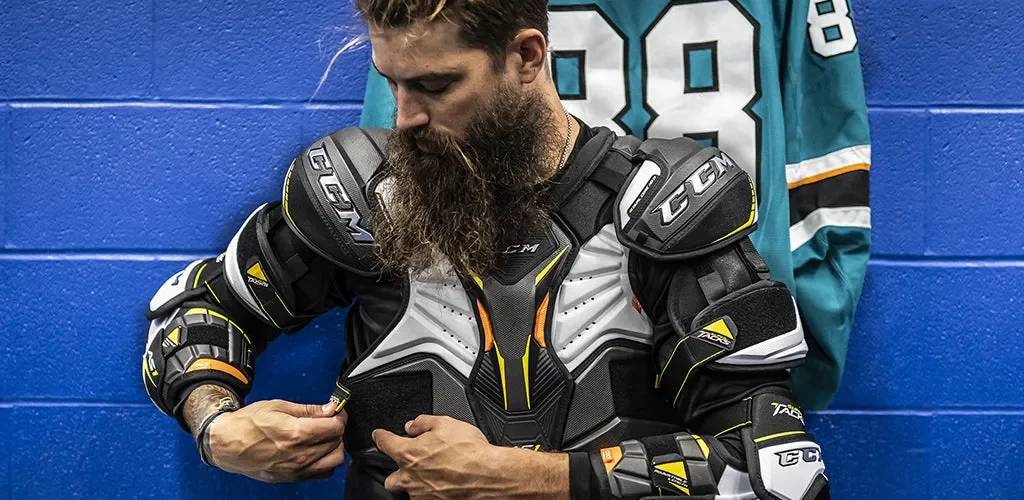
Modern shoulder pads have come a long way from their bulky beginnings. Today’s sports protective gear strikes a perfect balance between safety and performance. Athletes rely on these essential pieces of equipment that use cutting-edge materials and body-friendly designs to protect them from hard hits. Razor shoulder pads and other innovative designs are revolutionizing this category of protective sports accessories.
Reinforced shoulder pad materials
High-quality shoulder pads feature multiple layers that work together to protect players. The outer layer uses hard plastic shells made from polyethylene and polypropylene that spread out the force from impacts. The best models use advanced materials like carbon fiber or CURV™ thermoplastic. These materials give players the best protection while staying lightweight.
The padding system underneath provides crucial shock absorption. Top models come with:
- Dual-density foam with quilted lining
- Air management cushioning systems that spread out the force
- Anti-microbial treatments to reduce odor-causing bacteria
Recent advances include fabrics that pull sweat away from the body during intense games. Players also benefit from impact-resistant padding designs that let air flow freely without reducing protection.
Shoulder pad pricing and sizing
Quality shoulder pads come at different price points based on features and position-specific designs:
- Youth sizes start at $89.99 for basic models
- Mid-range options like Schutt XV FLUX series cost about $259.00
- Advanced models range from $300-$349
- Pro-grade pads with back plates can cost up to $749.99
Players can choose designs that match their position. Quarterbacks and receivers prefer “Skill” cuts for better movement. “All-Purpose” designs work well for multiple positions. Linemen need “Trench” models that offer extra protection. These options showcase the versatility of customizable protective gear in meeting specific needs.
Athlete feedback on shoulder pad performance
Pro athletes now lean toward sleek, lightweight shoulder protection designs that help them move freely. NFL defensive end Michael Bennett stands out by wearing kicker-sized pads despite his 6’4″, 280-pound frame. He says, “Small pads make me a better pass rusher”.
Players say new designs with good air flow help them bounce back faster after big hits. College athletes at top programs like IMG Academy love how lightweight models keep them safe without holding them back.
Players need gear that protects them while letting them perform their best. The right shoulder pads protect against impacts and allow free movement. This combination helps athletes stay safe while reaching their full potential on the field, exemplifying the balance between protection and performance in modern razor gear.
Multi-Layer Shin Guards with Compression
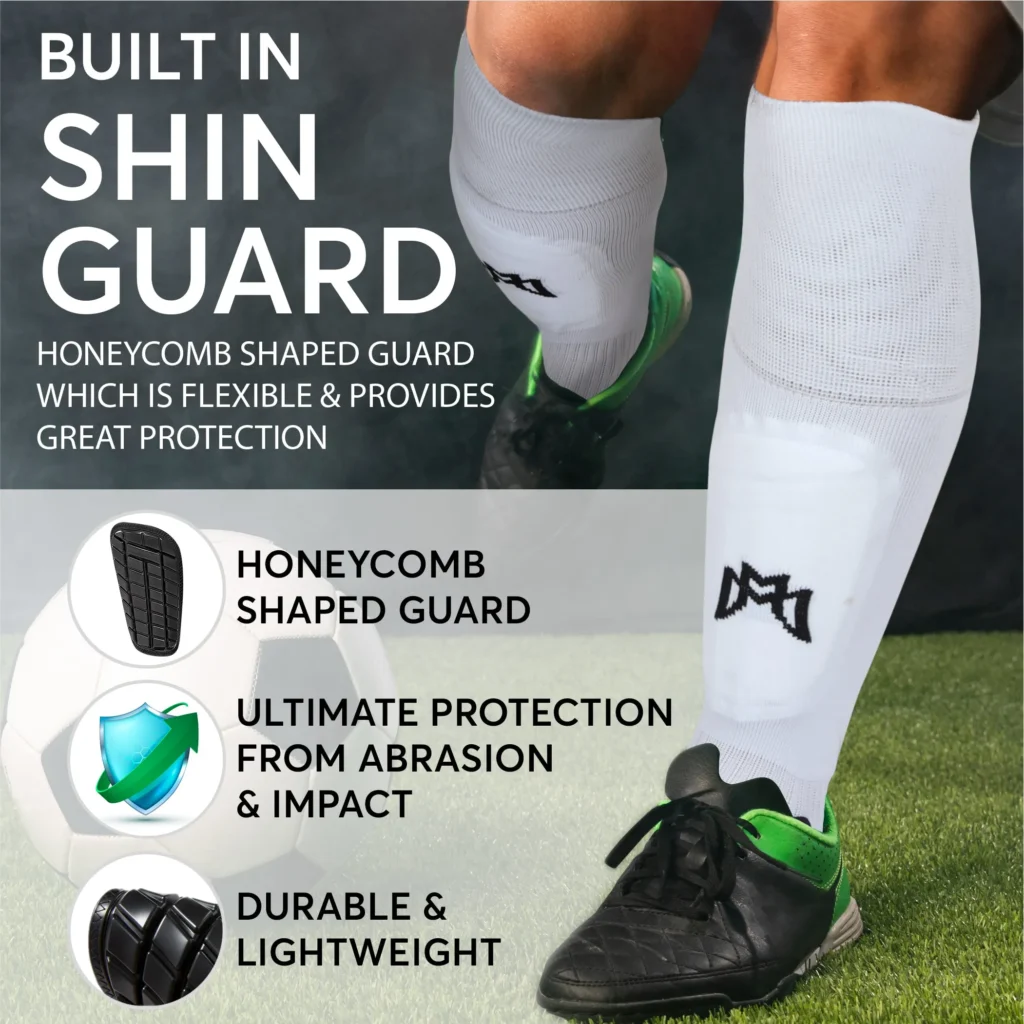
Contact sports have seen remarkable progress in shin protection through the combination of multi-layered padding and compression technology. This blend creates sports protective gear that protects against impacts and improves athletic performance.
Compression-integrated shin guard design
Modern shin guards feature innovative design elements that focus on protection and mobility:
- Multi-layered padding with pre-curved construction that fits leg contours naturally
- Silicone bead technology with hundreds of beads embedded in the inner lining to keep the guard stable during intense movement
- Honeycomb EVA padding that molds to the leg while absorbing impact effectively
The real breakthrough lies in merging these protective elements with compression sleeves. These designs create a secure fit through the compression sleeve instead of straps or tape. They often feature moisture-wicking fabrics to keep athletes dry and comfortable. Some advanced models also include graduated compression to boost blood circulation and reduce muscle fatigue during long games, showcasing the integration of performance safety wear with protective functionality.
Shin guard pricing and comfort
Quality shin protection prices vary based on design and features:
Basic slip-in guards cost between $8.00 to $15.00 per pair. High-end compression-integrated shin guards with ankle protection cost $25.00 to $50.00.
These guards now come with sophisticated comfort features like breathable mesh fabrics for better airflow. Many models use single-contoured seams that provide optimal calf compression without pressure points. Well-designed compression elements reduce swelling and support muscles, offering more benefits than traditional guards.
Why soccer and hockey players love them
Soccer players prefer compression-integrated shin guards because they stay in place during play. A player mentioned, “Once you get hit once you realize just how helpful they are”. Players enjoy better ball control with these sleek guards without compromising protection.
Hockey players value these guards for different reasons. The compression helps blood flow during intense skating, which delivers oxygen and nutrients to muscles more effectively. Players experience less muscle soreness and recover faster between shifts.
The lightweight construction works great for both sports. It meets safety requirements without restricting movement. Youth athletes find these guards particularly helpful since they don’t need extra strapping or taping, making protection more available and consistent. This versatility makes them an excellent example of innovative protective equipment suitable for various sports.
Smart Compression Sleeves with Injury Alerts

Smart compression sleeves have evolved beyond simple muscle support and now include sports protective gear that actively monitors injury risk. These sleeves blend athletic performance with preventive healthcare in an innovative way, representing a significant advancement in high-tech sports protection.
How smart sleeves detect injury risk
Smart compression sleeves use advanced sensor systems to spot potential injuries early. The intelligent garments employ:
- Proprioception enhancement technology that helps the body sense injury and adjust naturally
- 3D motion sensors about the size of a thumb drive track arm speed, elbow torque, and release points
- Vascular Refill Detection (VRD) measures venous refill time and adjusts compression cycles to optimize blood flow
- Patient Sensing Technology automatically detects whether compression therapy works effectively
The systems send live alerts when they detect mechanical fatigue during games or overtraining periods that might cause future injuries. Advanced models can move blood 1.5 times faster per hour compared to regular compression gear, showcasing the integration of cutting-edge protective technology with performance enhancement.
Smart sleeve pricing and battery life
Smart compression technology prices vary based on features:
Simple compression sleeves without electronics cost $8-$50 based on material quality and compression levels. Advanced smart sleeves with monitoring features cost $150-$500 for professional-grade safety gear.
Battery life has seen big improvements. Rechargeable lithium-ion models now offer:
- Premium models like Normatec last up to 2 hours
- Mid-range options like Therabody provide 6-hour battery life
- Portable units run for 3-4 hours of continuous monitoring
Best sports for smart compression sleeves
Baseball pitchers get great benefits from smart sleeves. These devices monitor vital metrics like elbow torque on the UCL and help prevent serious injuries that need Tommy John surgery. The benefits reach beyond baseball.
84.9% of endurance athletes say they recover faster with compression technology. Sports with repetitive motions show the highest injury prevention potential, including:
- Running and cycling (64.8% of endurance athletes use them for lower leg protection)
- Weightlifting (better proprioception prevents arm and shoulder injuries)
- Basketball and volleyball (less muscle movement during jumps)
These intelligent protective systems help prevent injuries and boost performance for athletes in a variety of disciplines, demonstrating the versatility of customizable protective gear in meeting diverse athletic needs.
High-Impact Chest Protectors for Goalies

Goalies must block shots that travel at over 90 mph. Their chest protection ranks among the most vital sports protective gear needed to prevent serious injuries. Modern protectors have evolved into complex defensive systems that combine multiple technologies, offering professional-grade safety gear for these high-risk positions.
Chest protector materials and coverage
Today’s goalie chest protectors use advanced materials in a layered defense system:
- HD foams and composite layers create a segmented construction that covers the upper body while maintaining mobility
- SHOCKLITE foams and Fuse Comp tech help Bauer models deliver professional-level protection with lightweight designs
- D3O® Smart Material protects highly vulnerable points at the sternum and collarbone in models like CCM EFlex 6 Pro
- Carbon fiber reinforcement helps premium models like the Vaughn Velocity V10 Pro Carbon protect against high-impact forces
These protectors also come with breathable mesh liners and AER-TEC ventilation systems that keep players comfortable during long games, showcasing the integration of impact-resistant padding with performance-enhancing features.
Chest protector pricing and fit
Quality chest protection costs vary based on performance level:
Hockey goalie chest protectors cost between USD 100.00 and USD 630.00, based on size and features. Youth models start at lower prices, while professional-grade protection commands premium prices.
Players should add their height and arm span measurements in centimeters to find the right fit. A proper chest protector should end 1-1.5″ from the wrists and fit snugly without movement restrictions. Pro models like Bauer Supreme MACH use AMP 2.0 Hinge Arm construction that moves with the body for continuous coverage, exemplifying the advanced design principles in modern athletic safety equipment.
Goalie testimonials on chest protection
Professional players prefer three brands on the ice: Bauer, Vaughn, and CCM. One goalie praised the CCM Premier: “It takes up much more space than its predecessor while maintaining the lightweight it was known for”.
In spite of that, one user raised a concern: “I’ve taken 2 ‘dingers’ right in the ‘CCM’ and felt bruising type pain for a couple of days after”. This experience shows why many goalies stress buying pro-level chest protection—”If you buy 2 top of the line things, make it your helmet and your chest, as it is protecting the most important parts of your body”.
Lightweight Elbow and Knee Guards
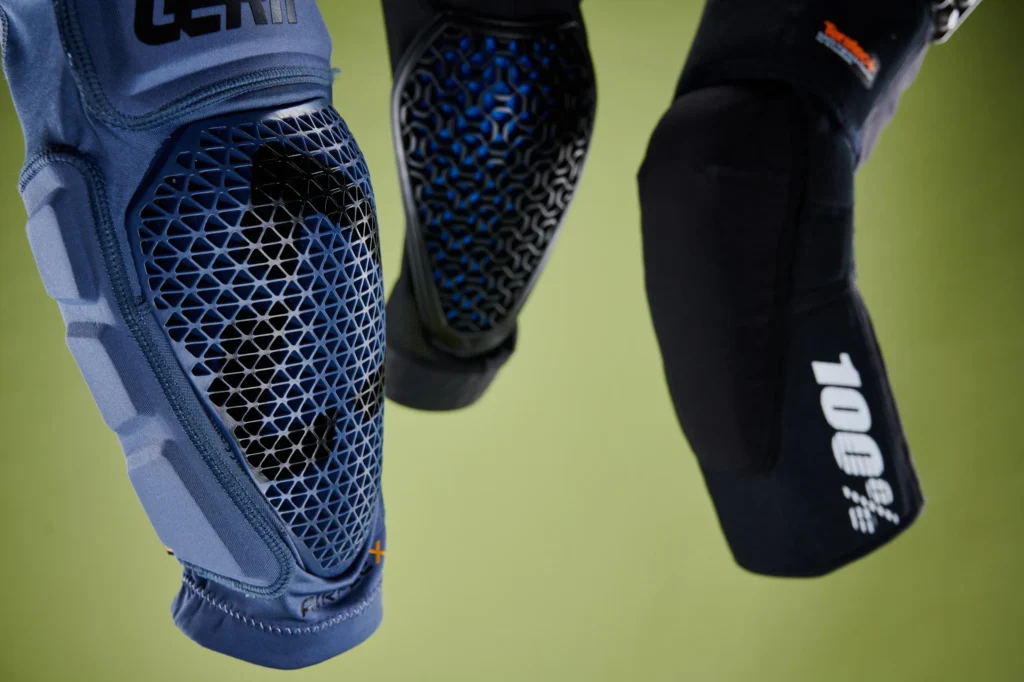
The rise of sports protective gear has made lightweight elbow and knee guards popular among athletes who want both mobility and protection. These safety elements have changed from bulky protectors to efficient performance equipment, incorporating shock-absorbing pads for enhanced protection.
Materials used in the 2025 elbow/knee guards
Elite guards now employ advanced materials that give maximum protection with minimal weight. Most guards have multi-layered construction with:
- 3D-molded silicone that stays flexible yet hardens upon impact
- Polyurethane foams that absorb shock well while staying lightweight
- D3O Smart Material that remains soft during movement but stiffens instantly when struck
- Mesh panels are placed at joint flex points to improve breathability
These innovations work with moisture-wicking fabrics and UPF 50+ compression materials to create protective equipment that moves with the body. Manufacturers now add anti-odor treatments so athletes can use the guards longer between washes, further enhancing the durability of these sports gear items.
Elbow and knee guard pricing
Quality guards come at different prices based on their technology:
EVS Option Knee Guard costs about $25.99 and gives simple protection for casual athletes. Mid-range guards like TP199 Lite Knee Guard cost around $87.99 and offer better protection with improved fit.
Premium models with advanced technology, such as the Slayco96 Knee Guard and Hex Pro Knee Guard, cost about $139.99 and $131.99, respectively. Mountain bikers often choose Terra mountain bike knee guards at roughly $109.99.
Why athletes prefer lightweight protection
Athletes first moved toward lightweight guards because of comfort. User testimonials show that traditional bulky guards caused arm pump and limited movement. This led to minimalist designs that protect without limiting performance.
Basketball players now wear lightweight knee and elbow pads more often because they protect without restricting movement. Mountain bikers look for guards that balance protection with pedal-friendliness. The Leatt Airflex Pro shows this balance well, weighing just 256 grams per pair.
Lightweight guards let athletes focus on their game instead of adjusting uncomfortable equipment. This confidence boost helps them perform better during competition, demonstrating how innovative protective equipment can enhance both safety and performance.
Wrist Guards with Motion Sensors

Wrist injuries make up about 25% of reported in-line skating accidents. This makes advanced sports protective gear a vital component for this vulnerable joint. The latest breakthroughs combine simple protection with smart technology that monitors movement patterns actively, showcasing cutting-edge protective technology in action.
How motion sensors prevent wrist injuries
Modern wrist guards now include sophisticated motion tracking technology that works to prevent injuries:
- Inertial measurement units (IMUs) monitor wrist movements live and detect harmful motion patterns
- Pressure sensors measure force during activities and identify excessive strain before damage happens
- Strain gages track tendon and muscle stress levels as movements repeat
The most impressive feature is the direct feedback these systems give users. The system alerts users to change their hand position when it detects harmful wrist flexion or overextension. This reduces the risk of conditions like carpal tunnel syndrome.
Studies indicate these smart guards can cut peak accelerations in the off-axis direction at the wrist by almost 50%. This significantly reduces impact forces during falls, demonstrating the effectiveness of impact protection technology in preventing injuries.
Wrist guard pricing and features
The market has options at different price points:
Simple traditional wrist guards cost between $25-$50 and provide impact protection without sensors. Mid-range options with simple motion detection features cost $87-$140.
Professional-grade models with complete sensor systems, live feedback, and smartphone connectivity cost $150-$500.
These guards feature breathable nylon mesh that keeps you comfortable, adjustable velcro straps for a custom fit, and EVA foam padding in strategic impact zones, showcasing the integration of comfort features with high-tech sports protection.
Best sports for wrist sensor gear
Some activities get more benefits from this technology:
- Snowboarding and skiing – falls on outstretched hands often cause wrist fractures
- Gymnastics – advanced gymnasts notice it affects their sense of position
- Mountain biking – wrist guards absorb shock on rough terrain
- Esports – prevents strain injuries during long gaming sessions
Snowboarders who use wrist guards see a 54% lower risk of injury without increasing shoulder injuries, highlighting the importance of targeted protection in sports injury prevention.
Thermoplastic Ankle Braces

Athletes often face ankle injuries that keep them off the field. Thermoplastic ankle braces have become vital sports protective gear that helps prevent injuries and speeds up recovery. These specialized supports blend rigid protection with body-friendly design to help athletes perform safely.
Thermoplastic ankle brace design
Modern ankle braces use thermoplastic elements as their core structure to provide excellent support. Top-performing designs include:
- Semi-rigid thermoplastic shells that offer inversion/eversion protection while staying lightweight
- Figure-8 strap systems that copy athletic taping methods for adjustable stabilization
- X-straps and heel locks that guard the most injury-prone ankle ligaments
Thermoplastic braces stand out because they adapt so well. Many models can be heated and molded to fit perfectly around the foot’s shape. This customization gives athletes the exact support they need where they need it most, exemplifying the benefits of customizable protective gear.
Ankle brace pricing and durability
Protection for your ankles comes at different price points based on technology:
Basic thermoplastic braces cost about $20-$30 per ankle. This makes them more economical than athletic tape, which adds up to $40-$60 per ankle each season. High-end models with extras like air cells or custom-molding options range from $87-$150.
Quality directly affects how long these braces last. Premium models made with carbon fiber and high-grade thermoplastic come with a limited 3-year warranty. They easily outlast several competitive seasons, demonstrating the durability of well-designed sports gear.
Athlete reviews on ankle support
Athletes love how these braces work on the field. Soccer players appreciate support that kicks in right when their ankle starts to roll or twist. College and pro basketball players like braces that keep them stable without limiting their movement.
The BetterGuard 2.0 earned this praise from one athlete: “It reacts 4x quicker than your body to automatically stabilize the ankle joint when needed most”. Athletes in many sports now prefer thermoplastic ankle braces because they offer this quick protection and improved blood flow from compression features, showcasing how innovative protective equipment can enhance both safety and performance.
Full-Face Shields for High-Speed Sports

High-speed contact sports can lead to severe facial injuries. Full-face shields serve as essential sports protective gear that protects players’ entire faces from flying pucks, sticks, and collisions. These shields are a crucial component of football protective equipment and other high-impact sports gear.
Face shield materials and visibility
Quality full-face shields use high-impact polycarbonate as their foundation. These shields offer exceptional impact resistance while maintaining clear vision. Modern models feature smart design elements to improve visibility:
- Interior anti-fog coatings stop condensation from building up inside
- Exterior anti-scratch coatings keep the shield clear all season
- Well-placed vents optimize airflow without reducing protection
- Wider visual areas that minimize distortion
Research shows these technical improvements help players maintain clear vision while staying safe. The Bauer Concept 3 takes this further by combining a wire cage’s airflow advantages with a solid shield’s better protection, demonstrating the ongoing innovation in enhanced visibility eyewear for sports.
Face shield pricing and certifications
You’ll find face shields at different price points:
- Simple models cost about $20-$50
- Better options with special coatings range from $50-$100
- Top-tier shields with advanced features cost $100-$200
Athletes should look for shields that meet safety standards like CSA, HECC, and CE certifications. These certifications prove the shield can handle powerful impacts common in fast-paced sports, ensuring the equipment meets professional-grade safety gear standards.
Why high-speed athletes rely on them
Studies show face shields cut down injury risk by a lot. Players who wear full protection see their risk of eye injuries drop by 4.7 times compared to those without it.
Protection goes beyond just the face. Players wearing full shields recover faster from concussions than those with half shields. College hockey players’ facial and dental injuries decreased with full protection, and it didn’t increase neck injuries.
Many sports now require this equipment. Hockey players aren’t the only ones who benefit. Baseball catchers, lacrosse players, and motorsport athletes all depend on full-face protection as standard safety equipment for sports.
Protective Cups with Ergonomic Design

Male athletes often overlook groin protection, though it’s a crucial part of sports protective gear. The protective cups we see today have come a long way from their steel predecessors. Modern designs focus on both safety and comfort during intense sports activities, incorporating innovative protective equipment principles.
Ergonomic cup design for comfort
The latest ergonomic cups match the body’s natural shape. Advanced models now include:
- Co-molded elastomer construction with polycarbonate cores that offer complete protection while staying flexible
- Soft edge technology that adapts to body contours and prevents pinching
- Ventilated designs with airflow channels that reduce heat and moisture
The tapered shape of modern cups makes them stand out. This design follows natural anatomy for better comfort and redirects impacts from sensitive areas to the stronger pelvic bone, showcasing how customizable protective gear can enhance both safety and comfort.
Protective cup pricing and sizing
Quality groin protection prices vary based on what you get:
Simple models cost about $25-$35, while better designs with ergonomic features run $34.99-$49.95. Top-tier models with polycarbonate cores (the same stuff in bulletproof glass) cost around $44.95-$49.95.
The right size matters just as much as quality. A poor fit won’t protect you well or feel comfortable. Here’s a quick size guide:
- Youth XS: 7 years and younger
- Youth Small: 9 years and younger
- Teen/Medium: 10-14 years
- Adult/Large: 15+ years
- Adult XL: 15+ with larger build
Sports where cups are essential
Medical experts recommend protective cups for all contact sports. The American Urological Association suggests boys should wear hard protective cups once they find properly sized options.
You need groin protection in these sports:
- Baseball and softball (especially when catching)
- Hockey
- Football
- Lacrosse
- Soccer
- Martial arts and boxing
- Rugby
Male athletes who play contact sports should treat protective cups as essential safety gear – just like helmets or shoulder pads. This emphasis on comprehensive protection aligns with the broader focus on sports injury prevention across all levels of athletics.
Eco-Friendly Sports Padding

The sports industry is seeing a green shift as eco-friendly padding becomes a greener choice for sports protective gear. Companies now create environmentally responsible safety equipment that doesn’t sacrifice performance or protection, aligning with the growing demand for sustainable athletic safety equipment.
Sustainable materials in sports padding
Leading companies are creating new paths in protective padding with these eco-friendly materials:
- Recycled polyester (rPET) forms the outer material and lining in products like Powerslide’s Standard Eco Set, which reduces environmental impact
- Recycled polyethylene foam makes up 99% of GreenFoam Pads that are free of lead, heavy metals, and rubber
- Bio-based feedstocks create the first-ever bio-based high-modulus polyethylene fibers that keep performance strong while using less fossil fuel
- Urethane-bonded granulated rubber absorbs shock for gym floors while supporting green practices
Products now meet UL GreenGuard Gold certification and ensure healthier indoor spaces by meeting strict off-gassing standards. On top of that, some makers recover production waste through new processes that turn discarded foam into eco-friendly padding parts, showcasing innovation in durable sports gear production.
Eco-friendly gear pricing
Sustainable padding is now available at different price points:
Entry-level eco-friendly protective sets start around $25-$50 and offer simple protection with sustainable materials. Mid-range options with recycled parts typically cost $87-$140 and provide better protection with stronger sustainability features.
High-performance, sustainable padding can cost $150-$250 for specific uses like hockey or skiing. Most makers price these products similarly to traditional options, which makes sustainable gear available to more athletes.
Why athletes are choosing green gear
Athletes now choose eco-friendly padding mainly because they want to reduce their environmental impact. Switching to sustainable materials cuts carbon footprints substantially—studies show products with bio-based fibers create 6.5 times less CO2 than regular options.
Athletes find performance benefits beyond helping the environment. New sustainable fabrics keep moisture away well, so athletes stay dry and comfortable during competition. Parents and schools prefer non-toxic, environmentally friendly options that keep safety standards high while reducing exposure to potentially harmful chemicals.
The push for sustainability grows stronger each day. Athletes now see their equipment choices as another way to help the environment without giving up protection, demonstrating how innovative protective equipment can align with broader environmental concerns.
Comparison Table
| Protective Gear | Price Range | Key Materials/Technology | Main Benefits | Target Sports/Users |
|---|---|---|---|---|
| Smart Helmets | $750-$1,500 | Accelerometers, gyroscopes, Bluetooth connectivity | Immediate impact detection, automated alerts | Football, motorcycle sports |
| Custom-Fit Mouthguards | $49-$500 | AI scanning technology, 3D printing | Better fit, 3.50mm thickness, improved protection | Rugby, football, contact sports |
| Polycarbonate Sports Eyewear | $49-$200+ | Polycarbonate lenses, UV protection coating | 10x more impact resistance, UV protection | Basketball, baseball, racquet sports |
| Reinforced Shoulder Pads | $89.99-$749.99 | Polyethylene, polypropylene, dual-density foam | Impact distribution, moisture-wicking | Football, hockey, contact sports |
| Multi-Layer Shin Guards | $8-$50 | Honeycomb EVA padding, silicone beads | Compression benefits, impact absorption | Soccer, hockey |
| Smart Compression Sleeves | $150-$500 | 3D motion sensors, VRD technology | Injury prevention, continuous monitoring | Baseball, endurance sports |
| High-Impact Chest Protectors | $100-$630 | HD foams, D3O Smart Material, carbon fiber | Professional-grade protection, ventilation | Hockey, lacrosse goalies |
| Lightweight Elbow/Knee Guards | $25.99-$139.99 | 3D-molded silicone, D3O Smart Material | Easy movement with protection, breathability | Basketball, mountain biking |
| Wrist Guards with Sensors | $25-$500 | IMUs, pressure sensors, strain gages | Movement tracking, injury prevention | Snowboarding, skiing, esports |
| Thermoplastic Ankle Braces | $20-$150 | Semi-rigid thermoplastic, Figure-8 strap systems | Custom-molded fit, stability | Soccer, basketball |
| Full-Face Shields | $20-$200 | High-impact polycarbonate, anti-fog coating | Complete facial protection, clear visibility | Hockey, baseball catchers |
| Protective Cups | $25-$49.95 | Co-molded elastomer, polycarbonate cores | Comfort-focused design, ventilation | Baseball, hockey, martial arts |
| Eco-Friendly Padding | $25-$250 | Recycled polyester, bio-based feedstocks | Earth-friendly, lower CO2 emissions | Multiple sports |
Conclusion
Sports protective gear has changed a lot, combining advanced technology with better safety features. Smart helmets detect impacts right away, and AI-fitted mouthguards give unmatched protection through precise customization. These breakthroughs have made protective equipment work better than ever.
Quality protection is now available to athletes at every level, with prices that fit different budgets. Simple protective gear costs between $20-50, while high-end smart equipment can run $500-1,500. You can find the right safety gear that works for you, whatever your budget or performance needs.
The numbers show how crucial proper protective gear really is. Athletes who wear custom-fitted mouthguards get 56% fewer concussions than those with store-bought ones. On top of that, polycarbonate eyewear stops 90% of potential eye injuries. Smart compression sleeves help cut down common strain injuries by spotting them early.
New sustainable options work just as well while being better for the environment. Bio-based materials and recycled parts deliver professional-grade safety with a much lower carbon footprint.
Your choice of protective gear affects both how well you play and how safe you stay. Smart technology, custom fitting, and environmentally responsible materials work together to keep you safer and help you perform better. As an athlete, choosing the right protective gear for your sport could be one of your most important decisions.
FAQs
Q1. Why is wearing protective gear crucial in sports?
Protective gear can be the difference between minor and severe injuries in many sports. It helps safeguard vital body parts, reducing the risk of head, spinal, and other serious injuries during high-impact activities.
Q2. Which sports require the most comprehensive protective equipment?
Football typically requires the most extensive protective gear, including helmets, shoulder pads, and various padding. Ice hockey and lacrosse also demand significant protective equipment to ensure player safety during intense physical contact.
Q3. What are some key protective gear items used across different sports?
Essential protective gear items include helmets, mouth guards, shoulder pads, knee pads, and sturdy shoes with cleats. For some sports, additional items like cups, hip pads, and shin guards are also crucial for comprehensive protection.
Q4. How has sports protective gear evolved in recent years?
Modern protective gear now incorporates advanced technologies like impact sensors in helmets, AI-fitted mouthguards, and smart compression sleeves that can detect potential injuries. These innovations offer enhanced protection and real-time monitoring of an athlete’s physical condition.
Q5. Are there eco-friendly options available for sports protective gear?
Yes, eco-friendly sports padding is now available, using sustainable materials like recycled polyester and bio-based feedstocks. These options offer comparable protection to traditional gear while significantly reducing environmental impact, making them increasingly popular among environmentally conscious athletes.



